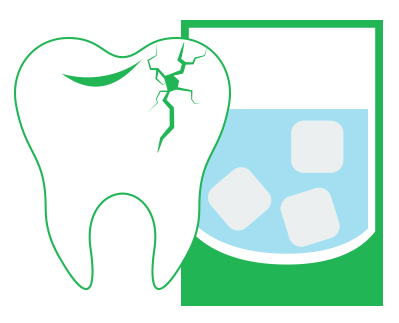Enjoying a cold drink usually involves a little ice. Sometimes larger pieces are hard to resist as teeth crunch them into smaller fragments. The sound of ice crystals shattering reverberates across a room unlike any other chewing activity; up to 250 pounds of force may be needed to break ice cubes with your teeth! Some people who chew ice may suffer from an iron deficiency and inflammation of the tongue. But ice-chewing often becomes a habit that simply needs to be broken.
This unique chewing habit carries a higher risk of damage to your teeth than chewing many other types of hard foods. Your teeth are made of mineralized layers that protect the soft inner nerve and blood supply found at the center of each one. Enamel, the hardest substance in your body, provides a unique armor as the outer layer. Intricate crystal rods comprise this remarkable covering, although it’s relatively brittle without the support of the layer underneath it.
If you compress firmly on an ice cube, an extreme temperature change occurs in the crystallized enamel. As the temperature suddenly drops, the crystal expands slightly. The temporary tension releases as the temperature rises again, a process amplified by the jaw force crushing the ice. Microfractures often form in teeth after thousands of normal chewing cycles. Ice accelerates the process.
Heed The Warning
Sometimes a cracked tooth gives you warning signs. But in other cases, the first clue is when a large chunk of tooth breaks off. Many of these teeth have large silver fillings in them and may appear dark from the amalgam staining that occurs over time. A broken tooth may be sensitive to cold and hot or have sharp edges that annoy the tongue, although they rarely ache. Don’t be fooled: a broken tooth needs attention to prevent further problems from developing down the road.
In other cases, a tooth sends you warning signals that it’s cracked and in danger of getting worse. If your tooth twinges with a cold drink but feels fine to chew on, it’s probably not damaged. If you’ve tried a sensitivity toothpaste for a couple of weeks without any change, you still might want to find out the cause. But if you bite down on certain foods and experience a sharp, sudden pain in the same area, you’d better schedule to see us. Usually, this means the crack is expanding slightly under pressure and will likely worsen over time.
What Do I Do?
A cracked tooth can usually be saved even when a piece breaks off. But if you’re experiencing bite pain and wait too long, the tooth may split and need to be removed. Teeth that ache for an extended period of time after chewing or hurt out-of-the-blue may have deeper cracks. Many of them can still be salvaged.
Your teeth handle a lot of use and abuse. But chewing ice leads to extra stress and possible problems that you just don’t need. Crunching on ice or hard candies may also damage porcelain restorations or other types of fillings. Many of these materials mimic tooth structure and can break if they’re misused.
If you’re experiencing any of the alarm bells mentioned above, we’ll help you sort out the reasons and the most conservative options for care. A couple of simple tests at Azalea City Dental helps confirm a crack and the best ways to limit the damage. So next time you’re tempted to break an ice cube in half with your teeth, let it melt...your teeth will thank you for it!




